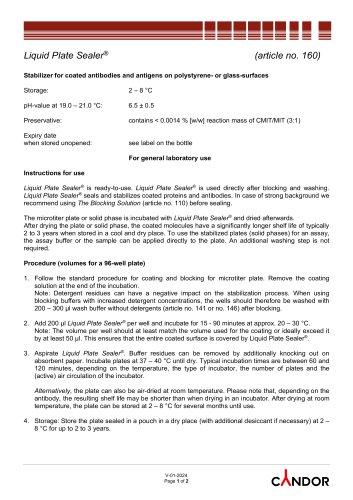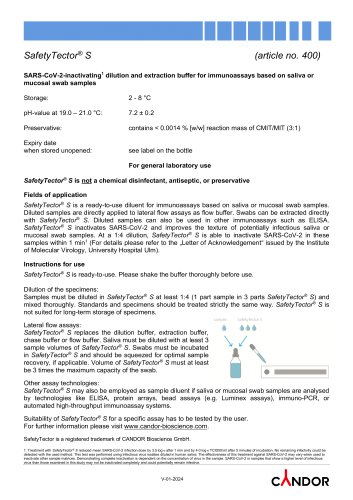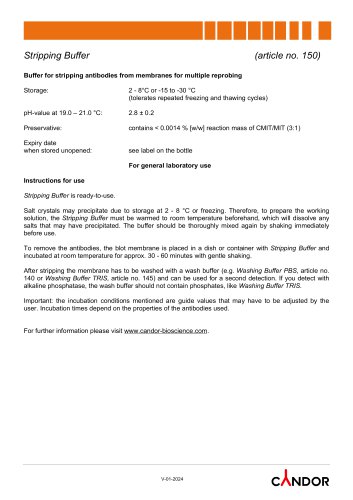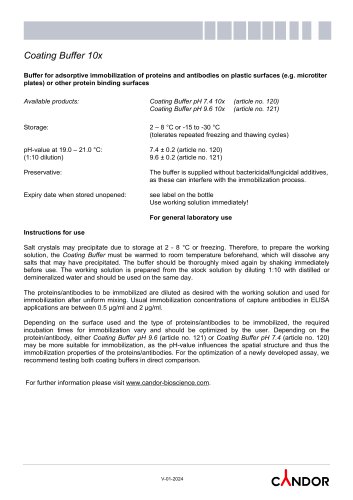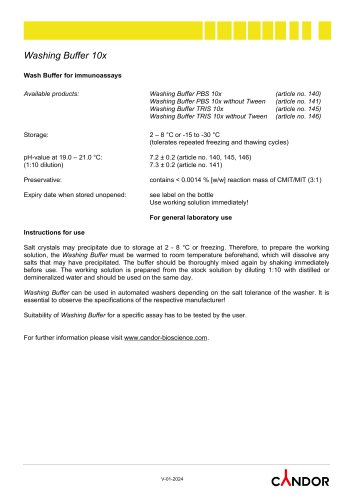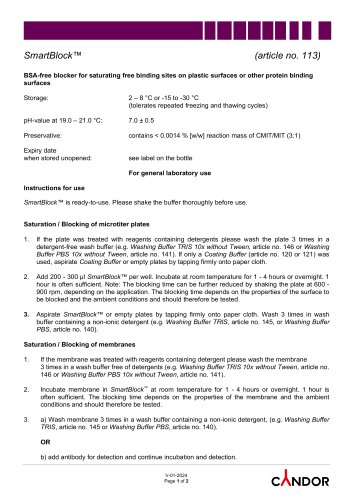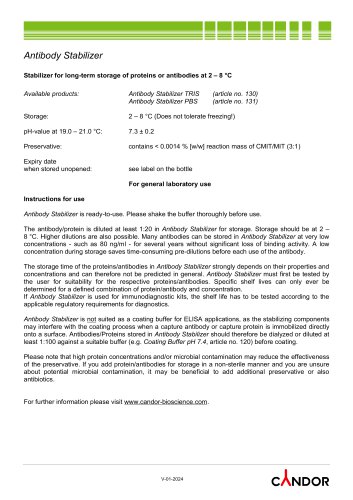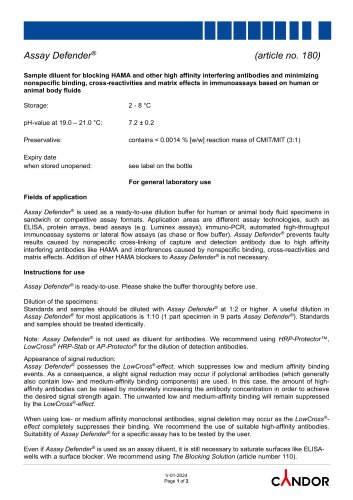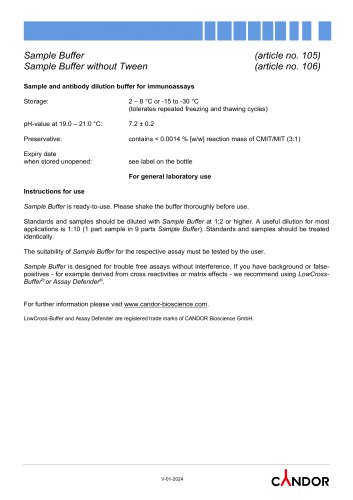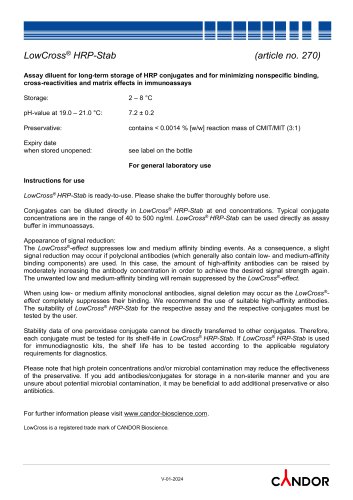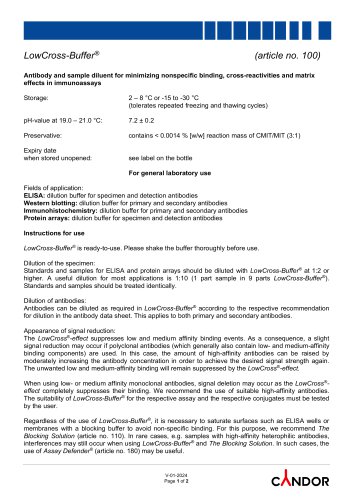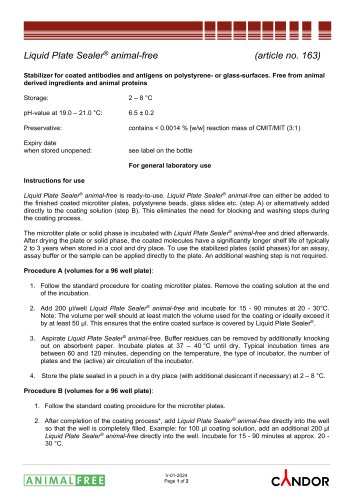 Website:
CANDOR Bioscience
Website:
CANDOR Bioscience
Catalog excerpts

Liquid Plate Sealer® Stabilizer for coated antibodies and antigens on polystyrene- or glass-surfaces Storage: contains < 0.0014 % [w/w] reaction mass of CMIT/MIT (3:1) Expiry date when stored unopened: see label on the bottle For general laboratory use Instructions for use Liquid Plate Sealer® is ready-to-use. Liquid Plate Sealer® is used directly after blocking and washing. Liquid Plate Sealer® seals and stabilizes coated proteins and antibodies. In case of strong background we recommend using The Blocking Solution (article no. 110) before sealing. The microtiter plate or solid phase is incubated with Liquid Plate Sealer® and dried afterwards. After drying the plate or solid phase, the coated molecules have a significantly longer shelf life of typically 2 to 3 years when stored in a cool and dry place. To use the stabilized plates (solid phases) for an assay, the assay buffer or the sample can be applied directly to the plate. An additional washing step is not required. Procedure (volumes for a 96-well plate) 1. Follow the standard procedure for coating and blocking for microtiter plate. Remove the coating solution at the end of the incubation. Note: Detergent residues can have a negative impact on the stabilization process. When using blocking buffers with increased detergent concentrations, the wells should therefore be washed with 200 – 300 μl wash buffer without detergents (article no. 141 or no. 146) after blocking. 2. Add 200 μl Liquid Plate Sealer® per well and incubate for 15 - 90 minutes at approx. 20 – 30 °C. Note: The volume per well should at least match the volume used for the coating or ideally exceed it by at least 50 µl. This ensures that the entire coated surface is covered by Liquid Plate Sealer®. 3. Aspirate Liquid Plate Sealer®. Buffer residues can be removed by additionally knocking out on absorbent paper. Incubate plates at 37 – 40 °C until dry. Typical incubation times are between 60 and 120 minutes, depending on the temperature, the type of incubator, the number of plates and the (active) air circulation of the incubator. Alternatively, the plate can also be air-dried at room temperature. Please note that, depending on the antibody, the resulting shelf life may be shorter than when drying in an incubator. After drying at room temperature, the plate can be stored at 2 – 8 °C for several months until use. 4. Storage: Store the plate sealed in a pouch in a dry place (with additional desiccant if necessary) at 2 – 8 °C for up to 2 to 3
Open the catalog to page 1
Alternatively, the plate can be stored directly at 2 – 8 °C without sealing. The shelf life of the plate is reduced to several months instead of years (due to the humidity present). We recommend sealing of the plate with an appropriate adhesive film. This reduces the influence of humidity and protects the plate from contamination during storage. For in-house laboratory use, this storage method is a good and frequently chosen option due to its simplicity. In this case, there is no need to add desiccant or seal the plate. The values given for shelf life are guidelines. Longer shelf lives have...
Open the catalog to page 2All CANDOR Bioscience catalogs and technical brochures
-
SafetyTector® S
1 Pages
-
Stripping Buffer
1 Pages
-
Coating Buffer 10x
1 Pages
-
Washing Buffer 10x
1 Pages
-
PlateBlock™
1 Pages
-
BSA-Block
1 Pages
-
SmartBlock™
2 Pages
-
ReadyTector
4 Pages
-
BUFFERS AND SOLUTIONS
20 Pages
-
The ELISA Experts
8 Pages
-
AP-Protector®
1 Pages
-
HRP-Protector™
1 Pages
-
Antibody Stabilizer
1 Pages
-
LowCross® HRP-Stab
1 Pages
-
Assay Defender®
2 Pages
-
Sample Buffer
1 Pages
-
Blocker selection
3 Pages
-
LowCross® HRP-Stab
1 Pages
-
LowCross-Buffer®
2 Pages

